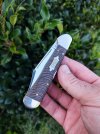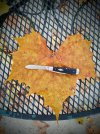Case has a new scale material that I am really liking, blue sycamore. I don't know much about sycamore, I'm guessing its dyed blue, but I may be wrong? Anyway, thoughts and opinions of sycamore as a knife handle would be appreciated! Eyeing a full size Case Trapper/blue sycamore.
-
The BladeForums.com 2024 Traditional Knife is ready to order! See this thread for details: https://www.bladeforums.com/threads/bladeforums-2024-traditional-knife.2003187/
Price is$300$250 ea (shipped within CONUS). If you live outside the US, I will contact you after your order for extra shipping charges.
Order here: https://www.bladeforums.com/help/2024-traditional/ - Order as many as you like, we have plenty.
You are using an out of date browser. It may not display this or other websites correctly.
You should upgrade or use an alternative browser.
You should upgrade or use an alternative browser.
Case Blue Sycamore handles?
- Thread starter jec88
- Start date
- Joined
- Sep 22, 2023
- Messages
- 802
I'm torn. I always thought sycamore was a pretty soft wood.
RickHuf
Gold Member
- Joined
- Jan 19, 2023
- Messages
- 2,104
It's similar to soft maple. If it's stabilized it shouldn't matter I would think.I'm torn. I always thought sycamore was a pretty soft wood.
Not sure if it's dyed blue while being stabilized or if it's just blue dye on raw wood....
lambertiana
Gold Member
- Joined
- Jul 7, 2000
- Messages
- 9,658
I'm torn. I always thought sycamore was a pretty soft wood.
Janka hardness for sycamore is 770. Sugar (Rock) maple is 1450, Black Walnut is 1010, white oak is 1350, and other maple species range from 700-950.
Compare this to some pines:
Eastern White 380
Ponderosa 460
Longleaf 870
Shortleaf 690
Loblolly 690
And the woods that have the longest history for use as knife handles:
Gabon Ebony 3080
Macassar Ebony (used by Buck for the 110/112 through least the mid 80s) 3220
African Blackwood (historically frequently sold as ebony) 3670
Cocobolo 2960
Desert Ironwood 3260
Last edited:
- Joined
- Sep 22, 2023
- Messages
- 802
Kinda proves my point.
I guess if it's not a hard use tool, it wouldn't matter.
I guess if it's not a hard use tool, it wouldn't matter.
- Joined
- Oct 28, 2023
- Messages
- 1,738
- Joined
- Oct 28, 2023
- Messages
- 1,738
Amazing detailed info!Janka hardness for sycamore is 770. Sugar (Rock) maple is 1450, Black Walnut is 1010, white oak is 1350, and other maple species range from 700-950.
Compare this to some pines:
Eastern White 380
Ponderosa 460
Longleaf 870
Shortleaf 690
Loblolly 690
And the woods that have the longest history for use as knife handles:
Gabon Ebony 3080
Macassar Ebony (used by Buck for the 110/112 through least the mid 80s) 3220
African Blackwood (historically frequently sold as ebony) 3670
Cocobolo 2960
Desert Ironwood 3260
lambertiana
Gold Member
- Joined
- Jul 7, 2000
- Messages
- 9,658
Hardness questions aside, the sycamore on these Case knives is striking material. If it is indeed stabilized, that will go a long way toward mitigating the natural softness of the wood.
For those who don't know what Janka hardness means, it is the number of pounds required to press a 7/16" steel ball to half of its diameter into the wood. It is a popular measurement for wood flooring because it is a direct measurement of the anticipated damage by things dropping onto the floor or by women wearing stiletto spike shoes. When I was an undergrad I had a job cleaning the floors in the admin building, and the areas frequented by stiletto wearing employees were a mass of shallow divots in the floor. 100 pounds on a stiletto spike converts to about 1500 PSI, with the impact of taking steps making it even more.
For those who don't know what Janka hardness means, it is the number of pounds required to press a 7/16" steel ball to half of its diameter into the wood. It is a popular measurement for wood flooring because it is a direct measurement of the anticipated damage by things dropping onto the floor or by women wearing stiletto spike shoes. When I was an undergrad I had a job cleaning the floors in the admin building, and the areas frequented by stiletto wearing employees were a mass of shallow divots in the floor. 100 pounds on a stiletto spike converts to about 1500 PSI, with the impact of taking steps making it even more.
Tyson A Wright
Gold Member
- Joined
- Jun 9, 2020
- Messages
- 1,901
Once you stabilize wood, I'm not sure the Janka hardness is totally relevant anymore. I mean, canvas can't even be rated on the Janka scale, but canvas Micarta is just stabilized canvas, and Micarta makes for a tougher knife scale than any unstabilized wood.
- Joined
- Sep 22, 2023
- Messages
- 802
Once you stabilize wood,
How is that done? Is it like pressure treating with glue?
- Joined
- Jul 4, 2017
- Messages
- 1,980
This is a bit off topic, but here goes...My parents actually have several Sycamore trees on their property. I can attest it is a softer wood. But as others have said it is stabilized so it is harder than it is normally.
There was a sycamore tree on my parents' property when I was growing up. (In fact, it's still there.) For some reason I could never remember the name "sycamore," so I developed a memory aid: I called it the "Indian tree." Here's how it worked: Indian > Mohawk > Mohican > Last of the Mohicans > James Fenimore Cooper > "Fenimore" sounds like... sycamore! The human mind is an incredible thing!
Tyson A Wright
Gold Member
- Joined
- Jun 9, 2020
- Messages
- 1,901
How is that done? Is it like pressure treating with glue?
I think they put it in vacuum to get all the air out, soak it in very slow epoxy, put it under pressure (K&G says they use 4000 pounds) to force the epoxy all through the wood, then let the epoxy cure. Done right, it's very solid.
lambertiana
Gold Member
- Joined
- Jul 7, 2000
- Messages
- 9,658
Once you stabilize wood, I'm not sure the Janka hardness is totally relevant anymore. I mean, canvas can't even be rated on the Janka scale, but canvas Micarta is just stabilized canvas, and Micarta makes for a tougher knife scale than any unstabilized wood.
Probably true. Janka hardness is used for untreated wood. Stabilizing can change everything. Does anyone know if these Case sycamore scales are stabilized?
- Joined
- Jul 30, 2006
- Messages
- 43,801
The Janka hardness method requires that the wood being tested have a moisture content of 12%.Janka hardness for sycamore is 770. Sugar (Rock) maple is 1450, Black Walnut is 1010, white oak is 1350, and other maple species range from 700-950.
Compare this to some pines:
Eastern White 380
Ponderosa 460
Longleaf 870
Shortleaf 690
Loblolly 690
And the woods that have the longest history for use as knife handles:
Gabon Ebony 3080
Macassar Ebony (used by Buck for the 110/112 through least the mid 80s) 3220
African Blackwood (historically frequently sold as ebony) 3670
Cocobolo 2960
Desert Ironwood 3260
But if you look at the commercial lumber web sites, the available sycamore wood is kiln dried. In North America, "kiln-dried" means a moisture content of 6-8%, and it's a North American wood. Lower moisture content means harder wood. That means the sycamore wood being used is harder than what the Janka hardness would indicate. Once dyed and stabilized, it will not absorb more moisture. So the Janka hardness readings for sycamore wood may be misleading. (My father was in the lumber business and dealt in kiln dried exotic hard woods. )



